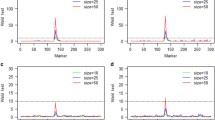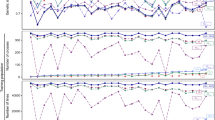Abstract
Most quantitative trait locus (QTL) mapping studies in plants have used designed mapping populations. As an alternative to traditional QTL mapping, in silico mapping via a mixed-model approach simultaneously exploits phenotypic, genotypic, and pedigree data already available in breeding programs. The statistical power of this in silico mapping method, however, remains unknown. Our objective was to evaluate the power of in silico mapping via a mixed-model approach in hybrid crops. We used maize (Zea mays L.) as a model species to study, by computer simulation, the influence of number of QTLs (20 or 80), heritability (0.40 or 0.70), number of markers (200 or 400), and sample size (600 or 2,400 hybrids). We found that the average power to detect QTLs ranged from 0.11 to 0.59 for a significance level of α=0.01, and from 0.01 to 0.47 for α=0.0001. The false discovery rate ranged from 0.22 to 0.74 for α=0.01, and from 0.05 to 0.46 for α=0.0001. As with designed mapping experiments, a large sample size, high marker density, high heritability, and small number of QTLs led to the highest power for in silico mapping via a mixed-model approach. The power to detect QTLs with large effects was greater than the power to detect QTL with small effects. We conclude that gene discovery in hybrid crops can be initiated by in silico mapping. Finding an acceptable compromise, however, between the power to detect QTL and the proportion of false QTL would be necessary.
Similar content being viewed by others
References
Beavis WD (1994) The power and deceit of QTL experiments: lessons from comparative QTL studies. Proc Corn Sorghum Ind Res Conf 49:250–266
Benjamini Y, Hochberg Y (1995) Controlling the false discovery rate: lessons from comparative QTL approach to multiple testing. J R Statist Soc B 57:289–300
Bernardo R (1996) Best linear unbiased prediction of maize single-cross performance. Crop Sci 36:50–56
Bernardo R (1998) Predicting the performance of untested single crosses: trait and marker data. In: Lamkey KR, Staub JE (eds) Concepts and breeding of heterosis in crop plants. Crop Science Society of America, Madison, pp 117–127
Bernardo R (2004) What proportion of declared QTL in plants are false? Theor Appl Genet 109:419–424
Delacy IH, Cooper M (1990) Pattern analysis for the analysis of regional variety trials. In: Kang MS (ed) Genotype-by-environments interaction and plant breeding. Louisiana State University Agriculture Centre, Louisiana, pp 287–300
Doerge RW, Zeng Z-B, Weir BS (1994) Statistical issues in the search for genes affecting quantitative traits in populations. In: Analysis of molecular marker data. Joint Plant Breed Symp Ser. American Society for Horticulture Science, Crop Science Society of America, Madison, pp 15–26
Emik LO, Terrill CE (1949) Systematic procedures for calculating inbreeding coefficients. J Hered 40:51–55
Fernando RL, Nettleton D, Southey BR, Dekkers JCM, Rothschild MF, Soller M (2004) Controlling the proportion of false positives in multiple dependent tests. Genetics 166:611–619
Glazier AM, Nadeau JH, Aitman TJ (2002) Finding genes that underlie complex traits. Science 298:2345–2349
Grupe A, Germer S, Usuka J, Aud D, Belknap JK, Klein RF, Ahluwalia MK, Higuchi R, Peltz G (2001) In silico mapping of complex disease-related traits in mice. Science 292:1915–1918
Haley CS, Knott SA (1992) A simple regression method for mapping quantitative trait loci in line crosses using flanking markers. Heredity 69:315–324
Hallauer AR (1990) Methods used in developing maize inbreds. Maydica 35:1–16
Henderson CR (1984) Application of linear models in animal breeding. University of Guelph, Ontario
Henderson CR (1985) Best linear unbiased prediction of nonadditive genetic merits in noninbred populations. J Anim Sci 60:111–117
Kearsey MJ, Farquhar AGL (1998) QTL analysis in plants; where are we now? Heredity 80:137–142
Kennedy BW, Quinton M, van Arendonk JAM (1992) Estimation of effects of single genes on quantitative trait. J Anim Sci 70:2000–2012
Lande R, Thompson R (1990) Efficiency of marker-assisted selection in the improvement of quantitative traits. Genetics 124:743–756
Lander ES, Botstein D (1989) Mapping Mendelian factors underlying quantitative traits using RFLP linkage maps. Genetics 121:185–199
Lynch M, Walsh B (1998) Genetics and analysis of quantitative traits. Sinauer Assoc, Sunderland
Mackay TFC (2001) The genetic architecture of quantitative traits. Annu Rev Genet 35:303–339
Panter DM, Allen FL (1995) Using best linear unbiased predictions to enhance breeding for yield in soybean: I. Choosing parents. Crop Sci 35:397–405
Parisseaux B, Bernardo R (2004) In silico mapping of quantitative trait loci in maize. Theor Appl Genet 109:508–514
Senior ML, Chin ECL, Lee M, Smith JSC, Stuber CW (1996) Simple sequence repeat markers developed from maize sequence found in the GENEBANK database: map construction. Crop Sci 36:1676–1683
Smith OS, Hoard K, Shaw F, Shaw R (1999) Prediction of single-cross performance. In: Coors JG, Pandey S (eds) The genetics and exploitation of heterosis in crops. Am Soc Agron Crop Sci, Crop Science Society of America, Madison, pp 277–285
Utz HF, Melchinger AE (1994) Comparison of different approaches to interval mapping of quantitative trait loci. In: van Ooijen JW, Janse J (eds) Biometrics in plant breeding: applications of molecular markers. CPRO-DLO, Wageningen, pp 195–204
Whittaker JC, Thompson R, Visscher PM (1996) On the mapping of QTL by regression of phenotypes on marker-type. Heredity 77:23–32
Acknowledgments
This research was funded by the United States Department of Agriculture National Research Initiative Competitive Grants Program (Plant Genomics - Bioinformatics) and supported in part by the University of Minnesota Supercomputing Institute.
Author information
Authors and Affiliations
Corresponding author
Additional information
Communicated by H.C. Becker
Rights and permissions
About this article
Cite this article
Yu, J., Arbelbide, M. & Bernardo, R. Power of in silico QTL mapping from phenotypic, pedigree, and marker data in a hybrid breeding program. Theor Appl Genet 110, 1061–1067 (2005). https://doi.org/10.1007/s00122-005-1926-7
Received:
Accepted:
Published:
Issue Date:
DOI: https://doi.org/10.1007/s00122-005-1926-7




